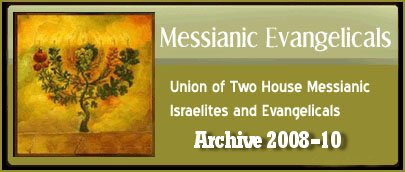RESOURCES
5-144000
A
B
C
D
E
F
G
H
I
J
K
L
M
N
O
P
Q
R
S
T
U
V
W
Y
Z
|
|

|
The New Moon - Conjunction or First Crescent?
Posted by Lev/Christopher on October 16, 2008 at 7:16pm
in Torah Studies
The following is a discussion on the New Moon from another group of ours:
Mathetes:
you have probably heard or read that the bible supposedly says nothing about how the first day of the lunar month is to be determined.
well, that is how I also thought until a about a year or two ago.
however, after studying in greater depth the calendar and improving my hebrew, that is no longer how I think about it.
but first, let me state a few basic things about the noon cycle.
as you probably know very well, the moon periodically goes through several phases as far as its visibility from the earth in clear weather is concerned:
(1) fist visible crescent
(2) first quarter
(3) second quarter
(4) full moon
(5) third quarter
(6) fourth quarter
(7) dark phase (for a day or two) when the moon is not visible from the earth even in if there are absolutely no clouds in the sky. this is the period of the CONCEALMENT of the moon due to the sun, moon, and earth being aligned, and the earth casting its shadow on the moon so that the moon is entirely covered by the shadow of the earth. It is also known as the CONJUNCTION or the astronomical new moon.
the commonly accepted method of determining the new moon is according to the first visible crescent. that method is the method not only in the talmud but that is also the islamic method, and that was also the method of ancient babylon.
however, there has been for many centuries an exception to that. that exception are the samaritans who since ancient times have been using the conjunction, the talmud claiming that they did that on purpose to mislead the jews.
but my intention is not to side with the first visible crescent camp or with the conjunction camp on the basis of extra-bibnlical sources. my intention is to present my understanding on purely biblical grounds.
I assert that according to the bible the method used at the time of king david, and therefore. the correct method, was according to the conjunction or rather according to the CONCEALMENT of the moon.
why do I assert that?
simply because of a couple of verses in the bible, and above all, because of psalm 81:3 (or 81:4 in the jewish editions)
let me give a few pf the extant translations in English of this verse and let me then show why these translations are all wrong:
King James Version 1611, 1769
Blow up the trumpet in the new moon, in the time appointed, on our solemn feast day.
NKJV
Blow the trumpet at the time of the New Moon,
At the full moon, on our solemn feast day.
New King James Version © 1982 Thomas Nelson
NLT
Sound the trumpet for a sacred feast when the moon is new, when the moon is full.
New Living Translation © 1996 Tyndale Charitable Trust
NIV
Sound the ram's horn at the New Moon, and when the moon is full, on the day of our Feast;
New International Version © 1973, 1978, 1984 International Bible Society
ESV
Blow the trumpet at the new moon, at the full moon, on our feast day.
The Holy Bible, English Standard Version © 2001 Crossway Bibles
NASB
Blow the trumpet at the new moon, At the full moon, on our feast day.
New American Standard Bible © 1995 Lockman Foundation
RSV
Blow the trumpet at the new moon, at the full moon, on our feast day.
Revised Standard Version © 1947, 1952.
ASV
Blow the trumpet at the new moon, At the full moon, on our feast-day.
American Standard Version 1901 Info
Young
Blow in the month a trumpet, In the new moon, at the day of our festival,
Robert Young Literal Translation 1862, 1887, 1898 Info
Darby
Blow the trumpet at the new moon, at the set time, on our feast day:
J.N.Darby Translation 1890 Info
Webster
Blow the trumpet in the new moon, in the time appointed, on our solemn feast day.
Noah Webster Version 1833 Info
HNV
Blow the shofar at the New Moon, At the full moon, on our feast day.
Hebrew Names Version 2000 Info
if you carefully compare these translations, you should notice that they differ in those place that I have given in bold type.
some have translated: “in the time appointed”, incl. the KJV, and even more of them have rendered the Hebrew phrase as “the full moon”.
one notable exception is the young literal translation where you will neither find “in the time appointed”, nor “the full moon”.
also, when translating the last part of the sentence. most translaters have used the preposition “ON” before “our feast day”.
well all these translations, even the HNV (what a surprise!) are wrong, the young literal translation being nearest to the truth among them.
however, even the Young translation used the preposition “at” before “the day of our festival”.
before I tell you what exactly is wrong with these translations, let me point that I do not say that the translators have deliberately given misleading translations in this case. Their problem rather stems from the following:
(1) obviously these translators were not well versed in the question of the phases of the moon.\below I will show that in greater detail)
(2) they were not very knowledgable in the torah, especially the feasts.
let me now proceed and give you my literal translation, which by the way I have also checked with expert sources.
psalm 81:3:
blow the shofar on the new moon, IN THE CONCEALMENT (in hebrew: be-kese), FOR (or TOWARD) the day of our feast.
one reason why translators disagree about the emboldened parts of the translation of this verse is that the literal translation of the hebrew expression did not make sense to them. very probably, they wondered what on earth “in the concealment” could mean. so some decided to render it “in the time appointed” and others “in the full moon”. only young obviously saw that both these are wrong and that not only on purely linguistic grounds.
the rendition “in the full moon” is wrong not only on linguistic grounds. the fact is, there is absolutely nothing in the entire torah about blowing the shofar on the FULL moon. i have checked also with rabbis, and they have told me that neither is there in the talmud any mention of such practice of blowing the shofar on the full moon. so the rendition “in the full moon” makes no sense not only on purely linguistic grounds.
since we already mentioned that there is a phase of the moon when the moon is CONCEALED from the view of observers from the earth even when there is nor a single cloud in the sky, we can easily understand what is meant by “in the concealment”.
also, the hebrew language of the bible is replete with examples (if you want, I can quote to you many) of saying the same thought in two different ways immediately one after the other. that is exactly the case with psalm 81:3. in fact the expressions “in the new moon” followed immediately by “in the concealment” is an excellent example of this practice in the biblical hebrew.
further, if we check where the torah mentions that a shofar should be blown on a new moon day, we shall see that that is a commandment concerning the first day of the seventh month “yom teruah” which means “day of raising noise” or as some incorrectly render it “day of trumpets” (lev. 23:24). and if you check that also with a rabbi, you will see that it is still a practice to blow the shofar on the first day of the seventh month.
now, in the light of the hebrew text of leviticus 23:24 it is obvious that psalm 81:3 is a biblical text that says that the first day of the biblical lunar month is the day when the moon is concealed, i.e. between a day or two earlier than the day of the first visible crescent.
now, there have been some objections to this interpretation of psalm 81:3 from certain caraites (jews that do not believe in the oral torah) on the grounds that the Hebrew word rendered as feast in 81:3 is the word “hag”. and they assert that there are only three feasts in the year which are called “hagim” in the torah, and these are the pilgrim feasts, i.e. the feasts when the jews are obliged to make a pilgrimage to the place of the temple or the place of the tent of meeting before the temple. they say that since yom teruah is not one of the hagim, then in their view it is a non-sense to say that the shofar should be blown “ON the day of our HAG” because yom teruah is not a HAG as they affirm.
now, i have carefully studied these objections and have come to the conclusion that such objections are wrong. they are wrong on several accounts. first, they are wrong because the presposition in hebrew is not “on (the day of our hag)” but rather “for” or even “toward (the day of our hag” (in hebrew: le-hageinu).
second, even if we render it “on”, there can be proven from the torah that at least one time a day which is not a pilgrimage day is called a “hag”, and that is the seventh day of the feast of unleavened bread, which is an annual sabbath and is called a hag (exodus 13:6). however, if we check if there must be a pilgrimmage on this day to the place of the temple (or holy tabernacle before that), we shall see that that is not the case. the first day of unleavened bread is indeed a pilgrimage day, but it is written in the torah that on the morning after the night of eating the passover lamb, the israelites should return to their tents, i.e. to their places of residence (deut. 16:7). that proves that they are not required to stay in the place of pilgrimage longer that the 15 of aviv. yet, we see that the 21st of aviv is also called a hag. also, the verb to which the word hag is connected (meaning to feast, to dance joyfully) is used in several places in the bible for days that are not one of the three hagim (15th aviv, shavuot or pentecost, and tabernacles).
but no matter how we interpret the word “hag”, the preposition before this word does not at all necessarily mean “on (the day of our hag)” because in its wider usage it means ”for”, “to”, “towards” and it also stands in the beginning of hebrew infinitive verb forms.
the expression “in the concealment” is used one more time in the Hebrew bible, namely in proverbs 7:20 and there it also means a set day of the month – obviously the day of the new moon, though here again the translators (with the remarkable exception of young) have given a wrong translation.
now, one can find in the bible other, though indirect, evidence that the change from the concealment to the first visible crescent was made exactly at the time of the babylonian captivity or immediately after that. But that I shall leave for another posting, if you are interested to know those facts.
-
Reply by machiera on October 19, 2008 at 5:20am
-
-
« Previous
1
2
Next »
|


This page was created on 5 May 2010
Updated on 5 May 2010
Copyright © 1987-2010 NCCG - All Rights Reserved
|
|


